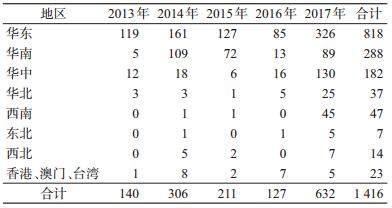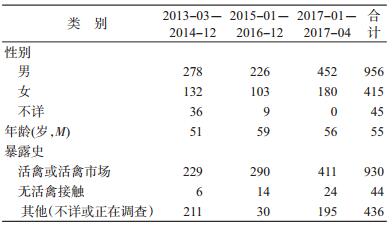引用本文

韩迪迪, 韩春霞, 李璐钰, 王明, 杨靖寰, 李曼. 中国2013-2017年人感染H7N9禽流感的流行病学特征[J]. 中华流行病学杂志, 2018, 39(1): 44-46

Han Didi, Han Chunxia, Li Luyu, Wang Ming, Yang Jinghuan, Li Man. Epidemiology of human infection with avian influenza A(H7N9) virus in China, 2013-2017[J].
Chinese Journal of Epidemiology, 2018, 39(1): 44-46.

中国2013-2017年人感染H7N9禽流感的流行病学特征
韩迪迪,
韩春霞,
李璐钰,
王明,
杨靖寰,
李曼

收稿日期: 2017-06-26
基金项目: 河北医科大学大学生创新项目(USIP2017125)
摘要:
目的
对我国人感染H7N9禽流感的流行病学特点进行分析,为H7N9禽流感的预防控制提供依据。方法
以2013年3月至2017年4月公开发表的人感染H7N9禽流感数据为对象,利用Excel 2007软件对数据进行统计学分析,描述其三间分布、暴露史及聚集性。结果
中国共确诊人感染H7N9禽流感病例1 416例,死亡559例,病死率为39.5%,2016年病例最少(127例),病死率最高(57.5%);报告病例前三位的省份主要是浙江、广东、江苏;发病年龄M=55岁,男女性别比为2.3:1,男性病例远多于女性。66%的病例在发病前确定有活禽相关暴露史,31%的病例暴露情况不详,仅有3%的病例无相关活禽暴露史。共发生35起家庭聚集性病例,共涉及72例病例,占总发病例数的5%。结论
H7N9禽流感疫情有较明显的季节分布及区域分布特点;存在有限的家庭聚集性;感染病例多与禽类接触有关。
关键词:
人感染H7N9禽流感
三间分布
预防
Epidemiology of human infection with avian influenza A(H7N9) virus in China, 2013-2017
Han Didi,
Han Chunxia,
Li Luyu,
Wang Ming,
Yang Jinghuan,
Li Man

School of Public Health, Hebei Medical University, Shijiazhuang 050017, China
Fund program: The Undergraduate Innovation Program of Hebei Medical University (USIP2017125)
Abstract:
Objective
To understand the epidemiological characteristics of human infection with avian influenza A (H7N9) virus in China, and provide evidence for the prevention and control of human infection with H7N9 virus.
Methods
The published incidence data of human infection with H7N9 virus in China from March 2013 to April 2017 were collected. Excel 2007 software was used to perform the analysis. The characteristics of distribution of the disease, exposure history, cluster of the disease were described.
Results
By the end of April 2017, a total of 1 416 cases of human infection with H7N9 virus were confirmed in China, including 559 deaths, the case fatality rate was 39.5%. In 2016, the case number was lowest (127 cases), with the highest fatality rate (57.5%). The first three provinces with high case numbers were Zhejiang, Guangdong and Jiangsu. The median age of the cases was 55 years and the male to female ratio was 2.3:1. Up to 66% of cases had clear live poultry exposure history before illness onset, 31% of cases had unknown exposure history and only 3% of the cases had no live poultry exposure history. There were 35 household clusters (5 in 2013, 9 in 2014, 6 in 2015, 5 in 2016, 10 in 2017), which involved 72 cases, accounting for 5% of the total cases.
Conclusions
The epidemic of human infection with H7N9 virus in China during 2013-2017 had obvious seasonality and spatial distribution. There was limited family clustering. Infection cases were mostly related to poultry contact.
Key words:
Human-infection with avian influenza A (H7N9) virus
Distribution of disease
Prevention
自2013年3月上海市和安徽省公布首批3例人感染H7N9禽流感(即病毒核酸检测阳性的临床患者),之后陆续发现并新增H7N9确诊病例。首个H7N9感染病例出现至今,人感染H7N9禽流感已经有5波周期性流行,分别为2013年3-4月,2013年11月至2014年4月,2014年11月至2015年4月,2015年11月至2016年4月,2016年10月至2017年4月,前4波病例有明显下降趋势[1],然而第5波来势汹汹,2016年12月的发病例数为既往同期病例的2.7~6.1倍[2]。为了解H7N9的疫情现状,以便为该传染病的实时防控提供科学依据,现对人感染H7N9禽流感病例的流行病学分布特征进行描述和分析。
资料与方法
1.资料来源:2013年3月至2017年4月WHO及国家卫生和计划生育委员会报告的实验室确诊人感染H7N9禽流感病例的公开数据[3-4]。
2.统计学方法:将所有病例相关资料(年龄、性别、发病时间、地区分布、暴露情况等)录入计算机,采用Excel 2007软件对数据进行统计学分析,绘制线图和直方图等,描述其流行病学特征。
结果
1.时间分布:2013年3月,上海市和安徽省首次发现人感染甲型H7N9禽流感病毒病例。截至2017年4月,我国累计出现1 416例人感染H7N9禽流感确诊病例,第1波和第2波报告病例数相近,第3波、第4波报告病例逐年下降。第5波的流行始于2016年10月,早于以往流行期,此后4个月H7N9禽流感病例显著增加,2017年1月发病人数达到292人(图 1)。人感染H7N9禽流感病死率较高,2013年3月至2017年4月,各年度病死率分别为34.3%、44.1%、43.6%、57.5%、33.4%(表 1)。
表 1 2013-2017年我国人感染H7N9禽流感发病及死亡情况
2.地区分布:1 416例H7N9感染病例广泛分布于全国28个省(自治区、直辖市)。统计数据显示,人感染H7N9禽流感病例与地区分布具有非常密切的联系,地域性明显,病例主要集中在华东、华南和华中地区(表 2)。发病例数排在前三位的省份为浙江(299例)、广东(258例)、江苏(243例),占全国总报告病例数的56.59%。
表 2 2013-2017年我国各地区人感染H7N9禽流感病例分布
3.人群分布:
(1) 年龄性别构成:1 416例病例中,男性956例,女性415例,比例约为2.3 : 1,性别不详45例(表 3)。病例年龄M=55岁,提示50~60岁人群为H7N9高发人群。
表 3 2013-2017年我国人感染H7N9禽流感病例基本特征
(2) 暴露情况:1 416例病例中,有过活禽和活禽市场接触史的为930例,明确表示无接触史的为44例,而接触史不详或正在调查者为436例,见表 3。
(3) 聚集性病例:是指7 d内在小范围(如1个家庭、1个社区等)发现≥2例,提示可能存在人际传播或因共同暴露而感染的人感染H7N9禽流感确诊病例或疑似病例。截至2017年4月,我国共发生35起家庭聚集性病例(2013年5起[5],2014年9起[5],2015年6起[5],2016年5起,2017年10起),累计72例。在35起家族聚集性病例中,发生在有血缘关系的亲属中的有23起,发生在无血缘关系但有密切接触的有8起。
讨论
本研究结果显示,H7N9发病时间集中,发病的高峰均出现在每年11月至次年4月,7-9月是发病的低谷时期,具有冬春季高发的季节性特点。
从地区分布上分析,确诊的H7N9病例主要集中在我国华东、华中和华南,有明显的地区聚集性。这可能与当地居民的活禽养殖、消费和饮食习惯有关。华东、华南地区自然环境和禽类销售链(销售市场80%主要集中在长江流域以南地区)可能是地区聚集性的主要原因之一[6]。华东和华南地区的地理条件相似,都是温暖潮湿,有利于病原体增殖,再加上华东和华南地区经济发达、人口密度大、人流量巨大,极易导致流行病的传播。
从人群分布特点分析,人感染H7N9禽流感确诊的病例中以男性、中老年人居多,这与前期的研究结果一致[7]。男性明显多于女性。这可能与我国男性较女性有较高的慢性呼吸道疾病患病率有关[6]。
从暴露情况来分析,大多数病例在发病前具有相关活禽暴露(暴露于活禽市场或活禽环境)的情况。已有研究表明,暴露在活禽的环境下,与感染H7N9病毒的风险增加有关[8]。而活禽市场的控制措施已确定能够有效控制H7N9禽流感暴发[9]。目前,确诊的人感染H7N9禽流感病例仍以散发状态为主,占总比例的95%。还没有充分的证据可以说明病毒可在人群中持续传播,但家庭聚集性病例的出现提示人传人的可能。
利益冲突:
无
参考文献
| [1] |
Xiang NJ, Li XY, Ren RQ, et al.
Assessing change in avian influenza A(H7N9) virus infections during the fourth epidemic-China, September 2015-August 2016[J]. MMWR Morb Mortal Wkly Rep, 2016, 65(49): 1390–1394.
DOI:10.15585/mmwr.mm6549a2 |
|
| [2] |
Zhou L, Ren RQ, Yang L, et al.
Sudden increase in human infection with avian influenza A(H7N9) virus in China, September-December 2016[J]. Western Pacific Surveill Response J, 2017, 8(1): 6–14.
DOI:10.5365/WPSAR.2017.8.1.001 |
|
| [3] |
Huo X, Chen L, Qi X, et.al.
Significantly elevated number of human infections with H7N9 virus in Jiangsu in eastern China, October 2016 to January 2017[J]. Euro Surveill, 2017, 22(13): pii=30496.
DOI:10.2807/1560-7917.ES.2017.22.13.30496 |
|
| [4] |
李鹏媛, 徐浩, 顾豪高, 等.
中国大陆H7N9禽流感病毒流行病学特征及血凝素和神经氨酸酶的分子进化[J]. 中山大学学报:医学科学, 2014, 35(6): 933–940.
Li PY, Xu H, Gu HG, et al.
Epidemiological characteristics of influenza virus H7N9 and evolutionary analysis of hemagglutinin and neuraminidase genes[J]. J Sun Yat-sen Univ:Med Sci, 2014, 35(6): 933–940.
DOI:10.13471/j.cnki.j.sun.yat-sen.univ(med.sci).2014.01.54 |
|
| [5] |
贾潇岳, 杜沛玲, 徐镇喜, 等.
人禽流感H7N9病例的流行病学特征分析[J]. 汕头大学医学院学报, 2016, 29(4): 229–230.
Jia XY, Du PL, Xu ZX, et al.
The charcteristic of human H7N9 cases[J]. J Shantou Univ Med Coll, 2016, 29(4): 229–230.
DOI:10.13401/j.cnki.jsumc.2016.04.016 |
|
| [6] |
Li J, Rao YH, Sun QL, et al.
Identification of climate factors related to human infection with avian influenza A H7N9 and H5N1 viruses in China[J]. Nat Sci Rep, 2015, 5: 18094.
DOI:10.1038/srep18094 |
|
| [7] |
Li Q, Zhou L, Zhou MH, et al.
Epidemiology of human infections with avian influenza A(H7N9) virus in China[J]. N Engl J Med, 2014, 370(6): 520–532.
DOI:10.1056/NEJMoa1304617 |
|
| [8] |
Zhou L, Ren RQ, Ou JM, et al.
Risk factors for influenza A(H7N9) Disease in China, a matched case control study, October 2014 to April 2015[J]. Open Forum Infect Dis, 2016, 3(3): ofw182.
DOI:10.1093/ofid/ofw182 |
|
| [9] |
Yu HJ, Wu JT, Cowling BJ, et al.
Effect of closure of live poultry markets on poultry-to-person transmission of avian influenza A H7N9 virus:an ecological study[J]. Lancet, 2014, 383(9916): 541–548.
DOI:10.1016/S0140-6736(13)61904-2 |
|
 2018, Vol. 39
2018, Vol. 39







